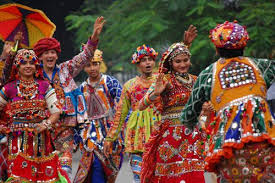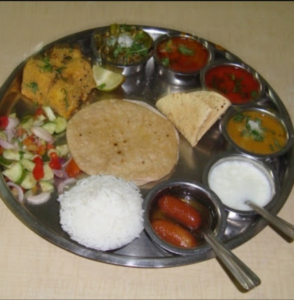
In many Gujarati communities, the engagement ceremony is known as Gaud Dhana (in Gujarati script, ગોળ-ધાણા),[1] which literally means “Jaggery and Coriander seeds” and refers to the practice of distributing a small amount of jaggery mixed with coriander seed
Gujarat dates back to the Indus Valley Civilization time, it contains ancient cities from Indua valley Lothal, Dholavira, and Gola Dhoro. The history provides evidence of trade ties with Egypt, Bahrain, and Sumer in the Persian Gulf.
Chandragupta Maurya conquered a number of places now what form Gujarat. Emperor Ashoka, the grandson of Chandragupta Maurya order engraving of his edicts in Junagadh rock. After the Maurya Empire, the Sakas controlled the region.
Gujarat Traditions
Gujarat carries its own culture and tradition which is clearly visible in day to day activities of people. Fairs and festival of Gujarat are very popular and there are about 1000 festivals celebrated in Gujarat.
Gujarat have its own wedding tradition too, their marriage is performed according to Vedas which consist of prayers, invocations, and vows recited in Sanskrit. The wedding ceremony takes place in mandap and the four pillar which surrounds the mandap are the parents of the bride and the groom.
The ceremony is performed before a sacred fire, or agniaa, which is the eternal witness of the marriage and all vows are taken.
Gujarati Language
Indo-Aryan language evolved from Sanskrit Gujarati is spoken in Gujarat. Whereas people of Kutch speak Kutchi while Memoni is also spoken among Sindhi memons and Muslims.
Gujarati Costumes

Gujarati has there own unique cultural dressing. The women main dress is Chaniyo & Choli, while men wear Chorno & Kediyu. The jewelry adorned by both male and female. The Gujarati outfits usually have thread work, use of beads, astragals, small patches which add creativity to Gujarati dresses.
Gujarati Cuisines

Gujarati cuisines are one of the healthiest cuisines in India and are primarily vegetarian. A Gujarati thali consists of roti, dal, rice, and sabzi with Indian pickle. Gujarati dishes are dhokla, pathra, samosa, Khaman while sweet dishes are mohanthal, jalebi, doodh pak.
Gujarati Music and dance
Gujarati folk music is called as Sugam Sangeet, while the instrument used are turi, bungal, pava, ravan hattho, ektaro, and jantar. The folk dance raas-garba is very popular of Gujarat when chaniya choli is worn by women while kedia is worn by men and they dance during Navratri celebrations.
Famous tourist attractions
Gujarat is one of the most popular states for tourism in India, it is popular for beautiful Great Rann of Kutch, hills of Saputara, there are many holy temples, historic capitals, wildlife sanctuaries, beaches, hill resorts to visit.
Gujarati Hindu wedding ceremony
Marriage is a highly auspicious occasion in Indian culture. According to the Vedas, the Hindu scriptures, marriage is a sacred lifelong commitment between a man and a woman. It is considered to be the strongest of all social bonds and is the initiation into a lifetime of togetherness.
The Vedic wedding ceremony consists of prayers, invocations, and vows recited in Sanskrit, the most ancient surviving language. The Vedic wedding ceremony dates back to over five thousand years and is performed under a decorated canopy, the mandap. The four pillars that surround the mandap represent the parents of the bride and groom. This signifies the important part they have played in raising their children to become the responsible adults they are today. The ceremony is performed before a sacred fire, or agniaa, which is the eternal witness of the marriage and all vows taken.
Parts of the ceremony
Every Hindu ceremony begins with the worship of Lord Ganesha, deity of peace and wisdom. This is done so people can find strength within themselves to remove any obstacles that may arise.
The original form of a barat is a procession from the groom’s house to the bride’s house for the wedding ceremony. The wedding day begins with the Mangal Vadya, the playing of Shehnai (a traditional wind instrument) and Dhol (Indian drum).
- Swagatam (Welcoming the groom and his family)
The groom and his family are greeted at the doors of the mandir (temple) by the bride’s parents and family. The mother of the bride then greets and welcomes the groom and his family into her own family. She blesses the groom by placing a tilak (red dot) on his forehead. The groom is then led to the mandap where the wedding ceremony will take place.
- Ganesh Puja (The worship of Lord Ganesh)
- Madhuparka (Welcoming the groom)
While the groom is sitting under the mandap the madhuparka is performed where his feet are washed by the bride’s parents. He is then offered panchamrut, a drink composed of milk, yogurt, ghee, honey, and sugar.
- Kanyaa Daan (Giving away of the daughter)
The bride accepts her change of status from an unmarried woman to a wife by spreading turmeric powder on her hands. Kanya Daan is performed by the father (or uncle of guardian) of the bride in presence of a large gathering that is invited to witness the wedding.
- Vivaaha (Wedding)
The bride and the groom face each other, and the priest ties their garments (the bride’s saree to the groom’s shirt) in a knot, symbolizing the sacred union. The bride and the groom garland each other and exchange the rings. Next the nuptial fire, symbolizing the divine witness, and the sanctifier of the sacrament, is installed and worshipped.
Both the bride and the groom grasp their hands together and pray to God for His blessings. Samagree, consisting of crushed sandalwood, herbs, sugar, rice, ghee (clarified butter), and twigs is offered into the sacred fire to seek God’s blessings for the couple.
- Mangal Phera (Circumambulation of the sacred fire)
The groom holds the bride by the hand and both walk three times around the sacred fire. Both offer oblations and recite appropriate Vedic hymns to Gods for prosperity, good fortune, and conjugal fidelity. They touch each other’s heart and pray for union of their hearts and minds.
- Saptapadi (Seven sacred steps)
This is the most important rite of the entire ceremony. Here the bride and the groom take seven steps together around the sacred fire (Agni) and make the following seven promises to each other: As per the Vedic rituals, the groom sings “With God as our guide, let us take”:
- The first step to nourish each other
- The second step to grow together in strength
- The third step to preserve our wealth
- The fourth step to share our joys and sorrows
- The fifth step to care for our children
- The sixth step to be together forever
- The seventh step to remain lifelong friends
- The perfect halves to make a perfect whole!
The Satapadi ceremony concludes with a prayer that the union is indissoluble. At the end of this ceremony, the groom and the bride become husband and wife.
- Mangal Sutra
The Mangal Sutra Dharana is the tying of the thread containing the marks of the Vishnu or Shiva on the neck of the bride by the groom.
- Suhaag or Sindhoordana
The groom places sindoor (red powder) on the bride’s hair symbolizing her as a married woman.
Aashirvaad (Blessing)
The groom’s parents bless the couple and offer clothes or flower to the bride, symbolizing her joining the groom’s family. All those assembled at the ceremony shower flowers on the couple and bless them completing the marriage.









